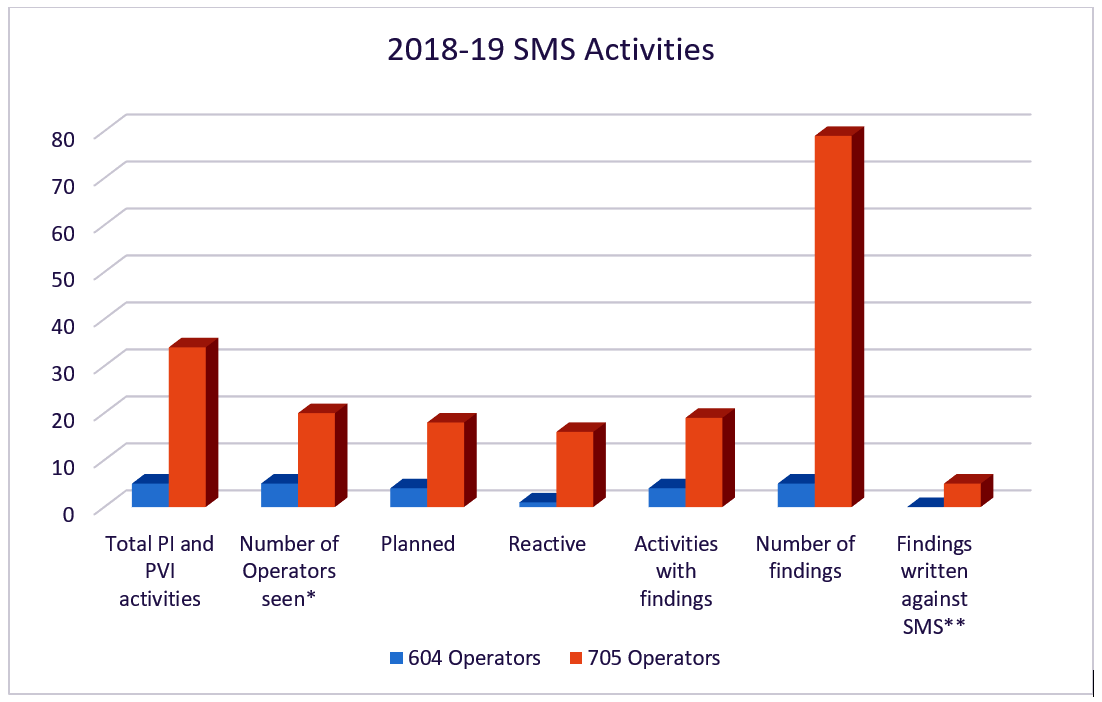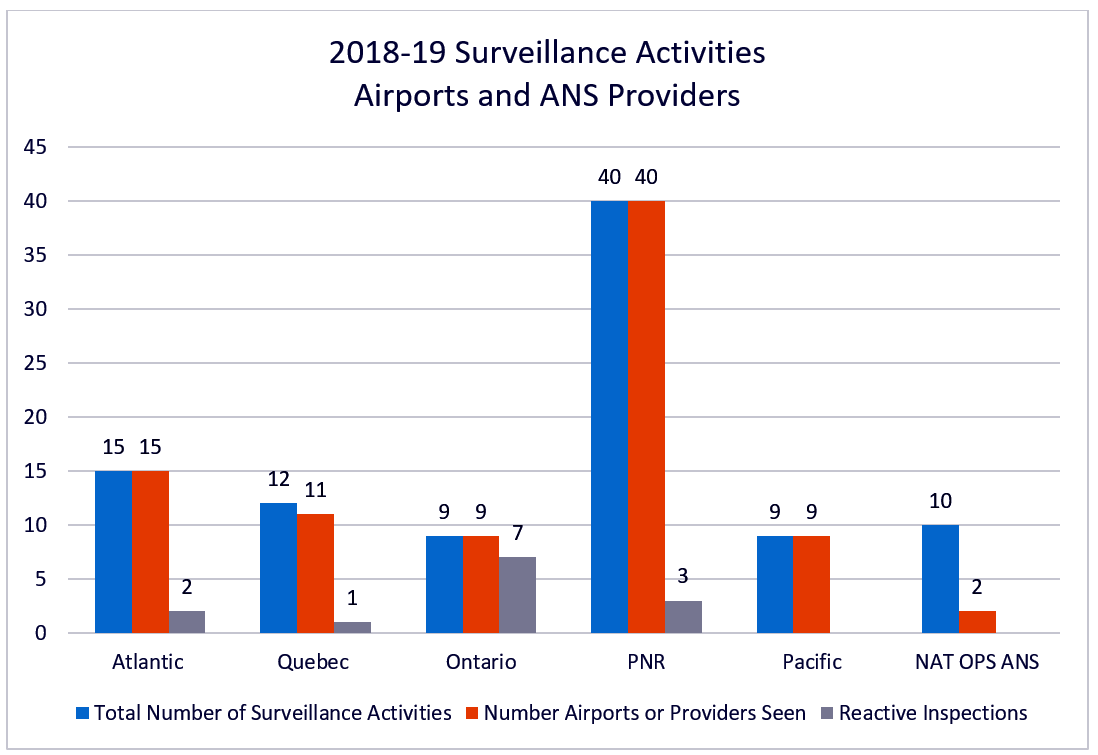This page presents an overview of Safety Management System related Oversight Activities conducted by Transport Canada Civil Aviation during the 2018-2019 fiscal year.
On this page
- Background
- Oversight Cycle
- SMS oversight activities results and statistics for 2018-2019
- Most common observations (trends)
- Conclusion
- Organizational Contact Information
Background
A SMS is a formal framework for managing risk. It helps companies manage safety by requiring them to:
- identify safety concerns, assess the level of risk they represent, and take steps to reduce those risks where required;
- set goals to improve aviation safety and measure the achievement of these goals;
- develop a procedure for employees to report safety hazards to the company, and a policy that protects employees who report to the SMS;
- ensure that employees are trained and competent;
- implement a quality assurance program; and
- regularly review the safety management system to make sure it is working effectively.
Transport Canada lets companies tailor their safety management systems to meet their unique operating needs within guidelines set out in the regulations.
In Canada, SMS is in place for:
- all airline operators;
- private operators;
- approved maintenance organizations who service airline operator aircraft;
- air navigation services; and
- airports.
Safety management systems haven’t rolled out to commuter, air taxi, and aerial work organizations, other approved maintenance organizations, flight training units, approved manufacturers, or aeronautical product certification.
Oversight Cycle
Transport Canada Civil Aviation (TCCA) plans which companies in the aviation industry will be inspected each year by assessing risk. Companies have been organized into peer groups based on their highest certificate type(s) so that TCCA can compare safety risk indicators. TCCA includes a company on the National Oversight Plan when its safety risk indicators are high compared to its peers.
Safety risk indicators are categorized into two major risk-based tiers: quantitative and qualitative.
| Quantitative risk indicators |
Qualitative risk indicators |
|
Time since last inspection |
Based on a questionnaire completed by the TCCA Inspectors responsible for each company |
|
Number of findings (during or since) last inspection |
|
|
Number of CADORS in a given period |
The default type of planned inspection is a process inspection (PI). Process inspections allow inspectors to look at a company’s processes to see if they:
- are effective;
- consistently reach their goals; and
- result in regulatory compliance.
Healthy processes provide confidence that the company systems they support are also effective. On the other hand, processes that do not consistently achieve compliant results can point to problems with the system as a whole. In this way, process inspections can help pinpoint systemic breakdowns.
Process inspections may or may not evaluate SMS processes, depending on the certificate type, whether the company has SMS, and the scope of the inspection.
Where results of a process inspection point to systemic issues, TCCA can use reactive surveillance to explore and address those concerns. Reactive surveillance includes all inspection activities that are not captured on the National Oversight Plan and could include:
- targeted inspections
- compliance inspections
- process inspections
- program validation inspections, or
- SMS assessments
The type of inspection selected is based on which tool is best suited to respond to the information or event that triggered it.
SMS oversight activities results and statistics for 2018-2019
In light of new reporting requirements introduced through the multi-modal SMS planning and reporting, there are current revisions underway to TCCA internal data reporting criteria. The following SMS data was gathered from multiple sources, applications, and databases. As additional years of data are captured under these new requirements, the reporting of SMS activities will become more accurate and better reflect which SMS compliant enterprises received oversight throughout the year as well as the total number of SMS compliant enterprises.
*Nine 705 operators had more than 1 surveillance activity.
**All findings from 2 companies. Four against 107.02 and one against 107.03.
2018-2019 SMS Activities
|
Total PI and PVI activities |
604 Operators |
5 |
|
705 Operators |
31 |
|
|
Number of Operators seen* |
604 Operators |
5 |
|
705 Operators |
20 |
|
|
Planned |
604 Operators |
4 |
|
705 Operators |
18 |
|
|
Reactive |
604 Operators |
1 |
|
705 Operators |
16 |
|
|
Activities with Findings |
604 Operators |
4 |
|
705 Operators |
19 |
|
|
Number of Findings |
604 Operators |
5 |
|
705 Operators |
79 |
|
|
Findings written against SMS |
604 Operators |
Floor |
|
705 Operators |
5 |
2018-2019 Surveillance Activities Airports and ANS Providors
|
Atlantic |
Total number of Surveillance Activities |
15 |
|
Number of Airports or Providers seen |
15 |
|
|
Reactive Inspections |
2 |
|
|
Quebec |
Total number of Surveillance Activities |
12 |
|
Number of Airports or Providers seen |
11 |
|
|
Reactive Inspections |
1 |
|
|
Ontario |
Total number of Surveillance Activities |
9 |
|
Number of Airports or Providers seen |
9 |
|
|
Reactive Inspections |
7 |
|
|
PNR |
Total number of Surveillance Activities |
40 |
|
40 |
||
|
Reactive Inspections |
3 |
|
|
Pacific |
Total number of Surveillance Activities |
9 |
|
Number of Airports or Providers seen |
9 |
|
|
NAT OPS ANS |
Total number of Surveillance Activities |
10 |
|
Number of Airports or Providers seen |
2 |
Most common observations (trends)
- Some organizations are demonstrating that they are dealing with risks in a more systematic and documented way.
- Many organizations (especially large ones) are buying-into the concept of SMS.
- Practices that are essential to effective safety management systems are becoming more common within the aviation industry. For example: non-punitive reporting, executive commitment, hazard identification and mitigation. This suggests that safety management systems are having a positive impact on aviation safety.
- The implementation of SMS has improved in the last five years.
- Confusion respecting regulatory interpretations is partly due to:
- a need for detailed guidance for industry on how to implement SMS, and
- a need for timely and comprehensive training for Transport Canada inspectors.
- Challenges were identified in some parts of the country between Transport Canada inspectors and industry that could be improved with additional training for both groups.
Conclusion
We know that the civil aviation safety framework is a complex regulatory system and we have not always had the capacity to address outstanding issues, administrative updates, and limitations that exist in the Canadian Aviation Regulations (CARs).
As such, an internal SMS policy review is underway. The review will look at the initial SMS roll-out from 2005 to the present. This review aligns with Transport Canada’s work on modernizing regulations and other transformation projects.
The policy review will look at the regulatory approach, including the tools and documentation used to implement SMS in the following aviation sectors:
- CAR 705 Airline Operations
- CAR 573 Approved Maintenance Organizations for CAR 705
- CAR 302 Certified Aerodromes
- CAR 805 Air Navigations Services
- CAR 604 Private operators
Once complete, TCCA will be in a better position to address outstanding issues, administrative updates and limitations that exist in the Canadian Aviation Regulations (CARs). This will contribute to Transport Canada’s responsibility to make sure that Canadians have access to a transportation system which is safe, secure, efficient and environmentally responsible.
Organizational Contact Information
Transport Canada welcomes your comments on this report. Please send your feedback to:
Email: Questions@tc.gc.ca

